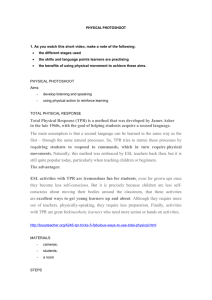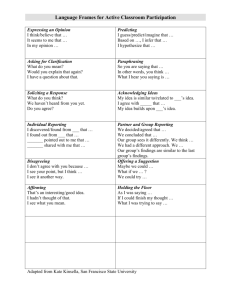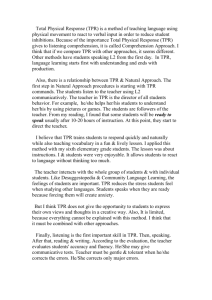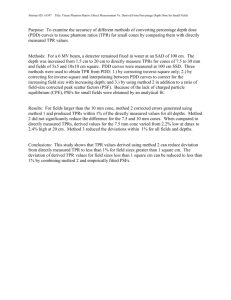this workshop's PowerPoint presentation here.
advertisement
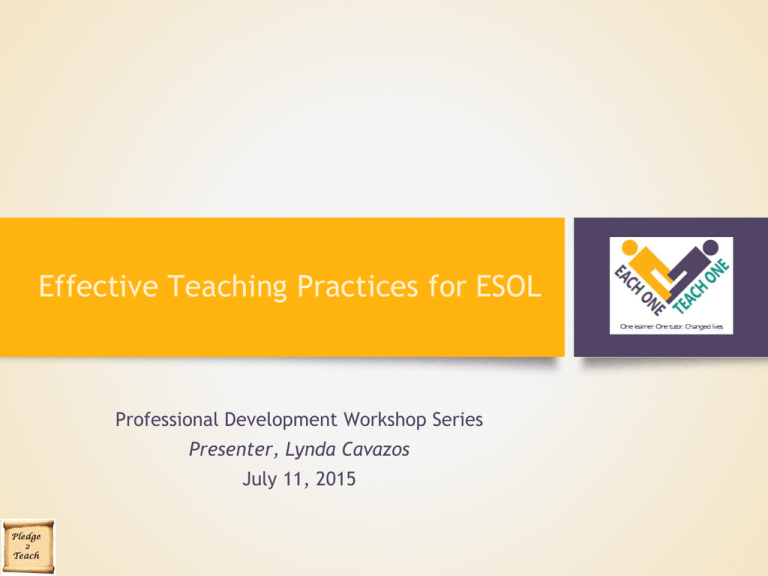
Effective Teaching Practices for ESOL Professional Development Workshop Series Presenter, Lynda Cavazos July 11, 2015 About Me • Classroom teacher for over 20 years • Adjunct Instructor at Texas A&M & U of H Victoria • Courses: Education, Bilingual Education, Curriculum and Instruction, and Early Childhood • PhD Candidate in Org Leadership at UIW • Educational Consultant • Texas State Certified Teacher Mentor Objectives • • • • How to incorporate language rich lessons How to create effective language activities How to implement effective teaching practices for ESOL How to create a goal plan of effective ESOL teaching practices • On chart paper, write a group name What to say instead of “I don’t know…” • • • • • May I please have more information? Could you please repeat the question? May I please ask a friend for help? Could you please rephrase the question? May I please have some time to think? Learning to Read and Write • On chart paper, each member draw a visual of how you learned to read and write • Rocking chair Numbered Heads Together • At your tables, number off from one to four • Think of how you implement language activities • Please stand when you can finish this phrase: One challenge English language learners face is. . • All the same numbers get together and share Research Article • Motivation and Motivating in the Classroom Talking to your students Mutual trust Enthusiasm Relaxed Learning is Relevant TESL Journal Dimitrios Thanasoulas Comprehensible Input Listening, speaking, writing, and reading Scaffold to provide support and knowledge • Ask many questions to check for understanding Communicate slowly, directly, and clearly Review constantly Be animated Comprehensible Input Low level LANGUAGE proficiency does NOT mean low level THINKING proficiency Pronunciation Goal is not to eliminate an accent Model clear speaking Demonstrate how each individual sound is produced (placement of lips, tongue and teeth) Clap or count syllables Pace speech Oral Element Warmers and Fillers for the first 5 minutes All lessons should include time to talk See handout, Vocabulary Warmers (Guess the Word) Review and discuss Wait Time It takes more than 1 to 2 seconds to process a question One second or longer to formulate and produce a response. When students are allowed 3 or more seconds to answer: - Saying “I don’t know” drops - Students produce longer and more correct answers - The length and correctness of their responses increase - They will want to volunteer more responses Eating Elephants You eat an elephant one bite at a time. Break the lessons into chunks Teaching verb tense • Do 1 lesson • Later, review the first lesson • Introduce a second chunk. Focus on Consonants • Comprehension depends more on recognizing the consonant letters than the vowels • The vowels are ommitted from the brief text: Whr r y lvng nw? Pls snd m yr pstl ddrss whn y hv tm. wld lk t snd y cpy f bk tht jst bght. • By contrast, the same text with the consonants omitted is impossible to decipher: ee ae ou ii o? eae e e ou oa ae e ou ae ie. I ou ie o e ou a o o a oo I u ou. • The comprehension of spoken English depends largely on the recognition of consonant sounds as opposed to vowel sounds Disco dance activity Tell me About • "What are you going to have for lunch?“ or "What did you do last night?" • Start your prompt with the three most useful words : "Tell me about ..." If you say "Tell me about what you did last night?" or "Tell me about what you're going to have for lunch?" • They will begin to reply with full sentences and use more language Numbers Count • Instead of saying “Talk about your home country,” say “Tell your partner 6 things about your home country.” • Instead of saying “Make some sentences from this picture,” say “Tell each other 5 sentences from the picture.” Accountable Talk Teachers Students Why do you think that? I notice… Why do you feel that way? I think.. Can you tell me more about that? I wonder.. I agree because.. I disagree.. I like… Conversational Skills • Having everyday conversation • See Conversation handout • Make a postcard • In pairs, practice talking about yourself using your postcard Friends or Acquaintances • Most of the words you have met are acquaintances • How you can turn students’ word acquaintances into word friends? • Teach and practice them, and then recycle them again and again over a period of time • Most ESL course books are not constructed for vocabulary recycling. • A good rule of thumb is to recycle words after one day, after one week, after two weeks, after one month, etc . 5 minute activity (warm up or filler) Grammar • Cartoon strip • Change the tense Spoon Feeding Correction • Students need to hear their own speech • Student A makes a mistake: He says "Yesterday I go to the bank.” • You shake your head to indicate something is wrong, and you say "Try again.” • Student A repeats the incorrect sentence. • You shake your head again and prompt the student by saying "Yesterday you?" (Or by saying "Go or went?" or "Go in the past?") • Student A says "Yesterday I went to the bank." TPR (Total Physical Response) by James Asher • Language teaching method • Based on coordination of language & physical movement • Brain compatible • Begins in infancy for developing L1 acquisition • “Pick up your toy” “Take my hand” • Critical period/Internalizing sounds and patterns • Respond to commands • Learn directions TPR Activity (Government) • Model • There are 3 branches of government (3 fingers) • The Executive branch (salute) carries out the law) rock arms together • The Legislative branch (L sign) creates the laws (write with hands) • The Judicial branch (hands on waist) judges the law (puts arm in front like giving something) • Practice together • Practice in groups The Art of Government TPR Activity (Driving a Car) • In groups, practice the TPR activity • • • • • • • • • • I I I I I I I I I I take my car key in my hand walk to the car unlock the car door or I use my remote to unlock the door open the car door get into the car close the door put on the seatbelt place the key in the ignition start the car drive off TPR Activity • As a group, come up with a TPR activity for a theme you are teaching • Be prepared to share Checking for Understanding • Language rich lessons need __________ • Effective language activities need _________ • Comprehensible input involves _____________ Role playing • An excellent way of providing students with oral practice • A script is helpful • Provide students with a series of written prompts, organized in the form of a visual (flowchart) • Something physical to hold on to • Gives them direction • See handout and practice Music Schoepp, Kevin, Reasons for Using Songs in an ESL Classroom, TESL Journal, Vol. VII, No. 2, February 2001 Human experience Integral part of language experience Reasons – linguistic, cognitive and affective Processing: Bottom up (sounds into words, sentences and meaning) Top down processing (background knowledge to understand the meaning of a message) Skills: language lexicon (vocabulary of person, language or knowledge) listening skills attitudes and feelings creativity and imagination relaxed classroom atmosphere • • • • Music • Brainstorm the title. Create a graphic organizer or a thinking map. • Without reading the lyrics, listen to the song twice and write down thoughts about the song. • What words do you hear? • What do you think the song is about? • Is this song happy or sad? Why? • Introduce vocabulary and its meaning. • Do a cloze activity with filling in the blank for every 5th word. • Using the lyrics, circle the verbs or adjectives. • Discuss the grammar is it more present or past tense. Was the grammar correct? • Make connections to the students’ lives and classroom themes. Music http://www.eslcafe.com/idea/index.cgi?Music: Music Activity • Discuss the title. What do you think the song is about? • What is the message of the song? Vocabulary • Focus on approximately 4-7 core vocabulary words per lesson. • Tie vocabulary to relevant experiences in the students' lives. • Practice an example • See handout Vocabulary (Window Paning) Conveys much information through visuals and little print Organizes steps for a process Cut into parts and reassembled again to demonstrate comprehension of a process Helps to remember important concepts or vocabulary words. Vocabulary Frog eggs Froglett Window Paning Tadpol e Tadpole with legs Adult Frog Work from Meaning to Word Using the word “chicken,” ask: “What’s the bird/animal that gives us eggs?” Have a discussion about chickens. More efficient to work from meaning to word. Create visuals/graphic organizers Visual Thinking Maps Pinterest Thinking Maps Graphic Organizers Comprehension Herringbone or Fishbone Organizer ..Enchanted Learning Story Map.. Enchanted Learning One Sentence Summary Frame Activity This article/information/story about _______ begins with the idea that __________ , develops the idea that ___________ and ends by saying _________. Comparison Frame ______ (is, are) the same as ___________ in several ways. First of all, ______________. Secondly, ____________ . In addition, _______________. Finally, _______________. It is clear that __________ and ___________ are alike in many respects. Questions Last thoughts??? Goal Plan and Reflection List 3 goals Share goals Reflection


